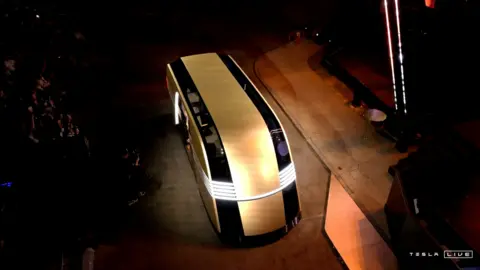Cybercab unveiled by Elon Musk

 Rating of the company Tesla, Inc
Rating of the company Tesla, IncTesla CEO Elon Musk unveiled the company’s long-awaited robot, Cybercab, at Warner Bros Studios in Burbank, California.
The futuristic-looking car, with two wing-like doors – and no pedals or steering wheel – put Mr Musk in front of an audience eager to hear details about a project he sees as key to Tesla’s next chapter.
At the event, titled “We, Robot,” the billionaire businessman also expressed his opinion that self-driving cars will be safer than those used by humans and can earn money for their owners by renting them out to ride them.
However, investors so far have not shared his enthusiasm – Tesla’s share price fell after the opening of markets in the US on Friday morning.
Its stock price fell more than eight percent, trading at around $219, at 11:45 Eastern Time (16:45 BST).
Meanwhile shares in ride-hailing rivals Uber and Lyft – which have their own aspirations for independence – were each trading up to 10% higher.
Questions are asked about Mr Musk’s prediction that production of the Cybercab will start sometime “before 2027”, given his history of failing to meet his deadlines.
“I tend to be optimistic about the timing,” he laughed during the event.
He said the Cybercab – which will compete with rivals including Alphabet-owned Waymo – will cost less than $30,000 (£23,000).
However, analysts have cast doubt on how genuine this plan is.
“It will be very difficult for Tesla to offer a new car at that price at that time,” said Paul Miller, of Forrester Research.
“Without external funding, even if Tesla makes a loss on every car, it doesn’t seem reasonable to launch at anything close to that price this decade,” he added.
Safety concerns
Mr. Musk also said he expects to see “completely autonomous and unsupervised” technology available in Tesla’s Model 3 and Model Y in Texas and California next year “subject to regulatory approval.”
But that approval is far from confirmed.
“It’s a lot of metal driving on roads at high speed, so the safety concern is huge,” said Samitha Samaranayake, an associate professor of engineering at Cornell University.
Tesla’s self-driving ambitions rely on cheaper cameras than radar and Lidar (light detection and ranging) sensors that are the technology core of many of its competitors.
By teaching its cars to drive, Tesla plans to use artificial intelligence (AI) trained on the raw data it collects from its millions of vehicles.
But the research community is “not sold on whether Tesla’s style of doing things can provide the safety guarantees we would like,” Mr Samaranayake said.
Playing catch
The Cybercab project has been delayed, from the start because of will be released in August.
This summer, in the post on X formerly of Twitter, Mr. Musk said the wait was due to design changes he felt were important.
Meanwhile, competing robots are already operating on some US roads.
Tesla also looks poised to post its first-ever annual sales decline as rivals pile into the electric car market, with sales softening.
Outside of that backstage, Tuesday’s event was more serious — complete with Tesla’s humanoid robots dancing and serving drinks to attendees.
Mr. Musk also revealed another prototype of “Robovan” that can carry about 20 passengers at a time.
The sliding shuttle “could be the way to go in the coming years for Tesla,” said Wedbush Securities managing director Dan Ives, who attended the event.
 Tesla/Reuters
Tesla/ReutersOne commentator said the event felt like a step back down memory lane while showing the way forward.
“Musk has done a great job of painting an ideal future for transportation that promises to free up our time and increase safety,” said Jessica Caldwell, head of insights at Edmunds.
But despite the show, there are doubts as to whether he can deliver on the vision he has outlined.
“There are many questions that remain about how this will be accomplished in a practical way,” Caldwell added.
State of the robotaxi market
Robotaxis deployments have met with setbacks, with self-driving cars being used by a subsidiary of General Motors. Cruise docked in San Francisco after a pedestrian was knocked to the ground.
But the sector continues to grow.
Waymo said in early October it will add the Hyundai Ioniq 5 to its fleet of robots after the vehicles are tested on the road with the company’s technology.
The ride-hailing giant Uber is looking to add more autonomous vehicles to its fleet to expand its delivery and ride-sharing options for customers.
It announced a multi-year partnership with self-driving car developer Cruise in August.
Chinese tech company Baidu is too it is reported that is looking to expand its robotaxi division, Apollo Go, beyond China – where the vehicles operate in several cities.
Additional reporting by Liv McMahon
Source link




